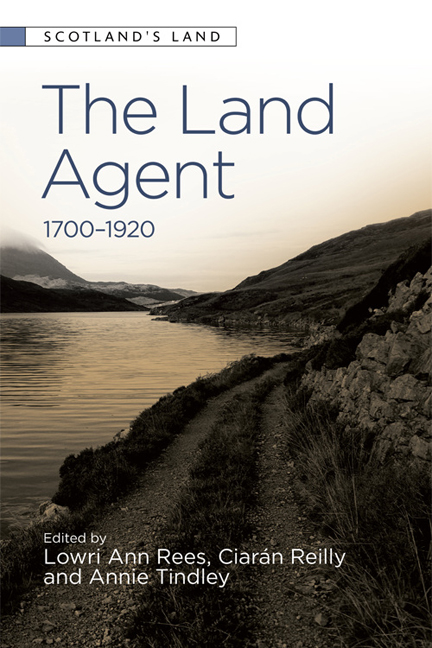Book contents
- Frontmatter
- Contents
- List of Figures
- Acknowledgements
- Notes on the Contributors
- Map of the British and Irish Isles
- Introduction
- Part I Power and its Constructions on Landed Estates
- Part II The Transnational Land Agent: Managing Land in the Four Nations and Beyond
- Part III Challenges and Catastrophe: The Land Agent under Fire
- 7 The Tenant Right Agitation of 1849–50: Crisis and Confrontation on the Londonderry Estates in County Down
- 8 Frustrations and Fears: The Impact of the Rebecca Riots on the Land Agent in Carmarthenshire, 1843
- 9 The Evolution of the Irish Land Agent: The Management of the Blundell Estate in the Eighteenth Century
- 10 ‘Between two interests’: Pennant A. Lloyd's Agency of the Penrhyn Estate, 1860–77
- Part IV Social Memory and the Land Agent
- Postscript
- Index
7 - The Tenant Right Agitation of 1849–50: Crisis and Confrontation on the Londonderry Estates in County Down
from Part III - Challenges and Catastrophe: The Land Agent under Fire
Published online by Cambridge University Press: 11 August 2018
- Frontmatter
- Contents
- List of Figures
- Acknowledgements
- Notes on the Contributors
- Map of the British and Irish Isles
- Introduction
- Part I Power and its Constructions on Landed Estates
- Part II The Transnational Land Agent: Managing Land in the Four Nations and Beyond
- Part III Challenges and Catastrophe: The Land Agent under Fire
- 7 The Tenant Right Agitation of 1849–50: Crisis and Confrontation on the Londonderry Estates in County Down
- 8 Frustrations and Fears: The Impact of the Rebecca Riots on the Land Agent in Carmarthenshire, 1843
- 9 The Evolution of the Irish Land Agent: The Management of the Blundell Estate in the Eighteenth Century
- 10 ‘Between two interests’: Pennant A. Lloyd's Agency of the Penrhyn Estate, 1860–77
- Part IV Social Memory and the Land Agent
- Postscript
- Index
Summary
INTRODUCTION
IN THE AUTUMN OF 1846, as the effects of the widespread attack of the fungus Phytophthora infestans on the potato crop in Ulster began to be felt, the Londonderry family of Mount Stewart, County Down owned or were co-lessees of several significant properties in Ulster. These comprised the Ballylawn estate near Manorcunningham on the eastern shore of Lough Swilly in County Donegal, an estate of some 7,000 statute acres founded on land acquired by a Scottish ancestor following the Plantation of Ulster. This was managed in conjunction with approximately 2,200 acres west of Muff (now Eglinton) in County Londonderry, and some property in Londonderry city itself acquired through a subsequent marriage into the Cowan family. In 1744 the Stewart family purchased the manors of Comber and Newtownards on the shores of Strangford Lough in County Down, which by 1848 had been significantly enlarged by the acquisition of adjoining townlands, together with the Florida estate near Killinchy, to comprise an estate of some 23,000 statute acres. In 1786 the family bought a half-share in the 23,000 statute acre Salters’ portion at Magherafelt in County Londonderry.
These estates were the property of Charles Stewart, 3rd Marquess of Londonderry (see Figure 6), who had inherited them in 1822 from his half-brother Robert Stewart, Lord Castlereagh and subsequently 2nd Marquess of Londonderry, who as Foreign Secretary had played a pivotal role at the Congress of Vienna. Charles himself had gained a fine reputation during the Napoleonic and Peninsular Wars as a bold and fearless leader of men. He also enjoyed some success as a diplomat, culminating in his appointment as Ambassador to Austria, in which capacity he, too, attended the Congress of Vienna.
In 1819 Charles Stewart had married secondly Frances Anne née Vane-Tempest, the only child of the wealthy British nobleman Sir Henry Vane-Tempest and his Irish wife Anne Catherine McDonnell, who was Countess of Antrim in her own right. Upon her father's death in 1813, Frances Anne inherited a 12,000-acre estate and sizeable colliery interests in County Durham, and upon the death of her mother in 1834, around 10,000 acres of the Antrim estate in County Antrim.
- Type
- Chapter
- Information
- The Land Agent , pp. 133 - 152Publisher: Edinburgh University PressPrint publication year: 2018



